Jun Zhou
Yilin
Rethinking Sample Polarity in Reinforcement Learning with Verifiable Rewards
Dec 25, 2025Abstract:Large reasoning models (LRMs) are typically trained using reinforcement learning with verifiable reward (RLVR) to enhance their reasoning abilities. In this paradigm, policies are updated using both positive and negative self-generated rollouts, which correspond to distinct sample polarities. In this paper, we provide a systematic investigation into how these sample polarities affect RLVR training dynamics and behaviors. We find that positive samples sharpen existing correct reasoning patterns, while negative samples encourage exploration of new reasoning paths. We further explore how adjusting the advantage values of positive and negative samples at both the sample level and the token level affects RLVR training. Based on these insights, we propose an Adaptive and Asymmetric token-level Advantage shaping method for Policy Optimization, namely A3PO, that more precisely allocates advantage signals to key tokens across different polarities. Experiments across five reasoning benchmarks demonstrate the effectiveness of our approach.
LLaDA2.0: Scaling Up Diffusion Language Models to 100B
Dec 24, 2025Abstract:This paper presents LLaDA2.0 -- a tuple of discrete diffusion large language models (dLLM) scaling up to 100B total parameters through systematic conversion from auto-regressive (AR) models -- establishing a new paradigm for frontier-scale deployment. Instead of costly training from scratch, LLaDA2.0 upholds knowledge inheritance, progressive adaption and efficiency-aware design principle, and seamless converts a pre-trained AR model into dLLM with a novel 3-phase block-level WSD based training scheme: progressive increasing block-size in block diffusion (warm-up), large-scale full-sequence diffusion (stable) and reverting back to compact-size block diffusion (decay). Along with post-training alignment with SFT and DPO, we obtain LLaDA2.0-mini (16B) and LLaDA2.0-flash (100B), two instruction-tuned Mixture-of-Experts (MoE) variants optimized for practical deployment. By preserving the advantages of parallel decoding, these models deliver superior performance and efficiency at the frontier scale. Both models were open-sourced.
MVInverse: Feed-forward Multi-view Inverse Rendering in Seconds
Dec 24, 2025Abstract:Multi-view inverse rendering aims to recover geometry, materials, and illumination consistently across multiple viewpoints. When applied to multi-view images, existing single-view approaches often ignore cross-view relationships, leading to inconsistent results. In contrast, multi-view optimization methods rely on slow differentiable rendering and per-scene refinement, making them computationally expensive and hard to scale. To address these limitations, we introduce a feed-forward multi-view inverse rendering framework that directly predicts spatially varying albedo, metallic, roughness, diffuse shading, and surface normals from sequences of RGB images. By alternating attention across views, our model captures both intra-view long-range lighting interactions and inter-view material consistency, enabling coherent scene-level reasoning within a single forward pass. Due to the scarcity of real-world training data, models trained on existing synthetic datasets often struggle to generalize to real-world scenes. To overcome this limitation, we propose a consistency-based finetuning strategy that leverages unlabeled real-world videos to enhance both multi-view coherence and robustness under in-the-wild conditions. Extensive experiments on benchmark datasets demonstrate that our method achieves state-of-the-art performance in terms of multi-view consistency, material and normal estimation quality, and generalization to real-world imagery.
Towards Pixel-Wise Anomaly Location for High-Resolution PCBA via Self-Supervised Image Reconstruction
Dec 22, 2025Abstract:Automated defect inspection of assembled Printed Circuit Board Assemblies (PCBA) is quite challenging due to the insufficient labeled data, micro-defects with just a few pixels in visually-complex and high-resolution images. To address these challenges, we present HiSIR-Net, a High resolution, Self-supervised Reconstruction framework for pixel-wise PCBA localization. Our design combines two lightweight modules that make this practical on real 4K-resolution boards: (i) a Selective Input-Reconstruction Gate (SIR-Gate) that lets the model decide where to trust reconstruction versus the original input, thereby reducing irrelevant reconstruction artifacts and false alarms; and (ii) a Region-level Optimized Patch Selection (ROPS) scheme with positional cues to select overlapping patch reconstructions coherently across arbitrary resolutions. Organically integrating these mechanisms yields clean, high-resolution anomaly maps with low false positive (FP) rate. To bridge the gap in high-resolution PCBA datasets, we further contribute a self-collected dataset named SIPCBA-500 of 500 images. We conduct extensive experiments on our SIPCBA-500 as well as public benchmarks, demonstrating the superior localization performance of our method while running at practical speed. Full code and dataset will be made available upon acceptance.
CangLing-KnowFlow: A Unified Knowledge-and-Flow-fused Agent for Comprehensive Remote Sensing Applications
Dec 17, 2025Abstract:The automated and intelligent processing of massive remote sensing (RS) datasets is critical in Earth observation (EO). Existing automated systems are normally task-specific, lacking a unified framework to manage diverse, end-to-end workflows--from data preprocessing to advanced interpretation--across diverse RS applications. To address this gap, this paper introduces CangLing-KnowFlow, a unified intelligent agent framework that integrates a Procedural Knowledge Base (PKB), Dynamic Workflow Adjustment, and an Evolutionary Memory Module. The PKB, comprising 1,008 expert-validated workflow cases across 162 practical RS tasks, guides planning and substantially reduces hallucinations common in general-purpose agents. During runtime failures, the Dynamic Workflow Adjustment autonomously diagnoses and replans recovery strategies, while the Evolutionary Memory Module continuously learns from these events, iteratively enhancing the agent's knowledge and performance. This synergy enables CangLing-KnowFlow to adapt, learn, and operate reliably across diverse, complex tasks. We evaluated CangLing-KnowFlow on the KnowFlow-Bench, a novel benchmark of 324 workflows inspired by real-world applications, testing its performance across 13 top Large Language Model (LLM) backbones, from open-source to commercial. Across all complex tasks, CangLing-KnowFlow surpassed the Reflexion baseline by at least 4% in Task Success Rate. As the first most comprehensive validation along this emerging field, this research demonstrates the great potential of CangLing-KnowFlow as a robust, efficient, and scalable automated solution for complex EO challenges by leveraging expert knowledge (Knowledge) into adaptive and verifiable procedures (Flow).
VPHO: Joint Visual-Physical Cue Learning and Aggregation for Hand-Object Pose Estimation
Nov 15, 2025Abstract:Estimating the 3D poses of hands and objects from a single RGB image is a fundamental yet challenging problem, with broad applications in augmented reality and human-computer interaction. Existing methods largely rely on visual cues alone, often producing results that violate physical constraints such as interpenetration or non-contact. Recent efforts to incorporate physics reasoning typically depend on post-optimization or non-differentiable physics engines, which compromise visual consistency and end-to-end trainability. To overcome these limitations, we propose a novel framework that jointly integrates visual and physical cues for hand-object pose estimation. This integration is achieved through two key ideas: 1) joint visual-physical cue learning: The model is trained to extract 2D visual cues and 3D physical cues, thereby enabling more comprehensive representation learning for hand-object interactions; 2) candidate pose aggregation: A novel refinement process that aggregates multiple diffusion-generated candidate poses by leveraging both visual and physical predictions, yielding a final estimate that is visually consistent and physically plausible. Extensive experiments demonstrate that our method significantly outperforms existing state-of-the-art approaches in both pose accuracy and physical plausibility.
Thinker: Training LLMs in Hierarchical Thinking for Deep Search via Multi-Turn Interaction
Nov 14, 2025Abstract:Efficient retrieval of external knowledge bases and web pages is crucial for enhancing the reasoning abilities of LLMs. Previous works on training LLMs to leverage external retrievers for solving complex problems have predominantly employed end-to-end reinforcement learning. However, these approaches neglect supervision over the reasoning process, making it difficult to guarantee logical coherence and rigor. To address these limitations, we propose Thinker, a hierarchical thinking model for deep search through multi-turn interaction, making the reasoning process supervisable and verifiable. It decomposes complex problems into independently solvable sub-problems, each dually represented in both natural language and an equivalent logical function to support knowledge base and web searches. Concurrently, dependencies between sub-problems are passed as parameters via these logical functions, enhancing the logical coherence of the problem-solving process. To avoid unnecessary external searches, we perform knowledge boundary determination to check if a sub-problem is within the LLM's intrinsic knowledge, allowing it to answer directly. Experimental results indicate that with as few as several hundred training samples, the performance of Thinker is competitive with established baselines. Furthermore, when scaled to the full training set, Thinker significantly outperforms these methods across various datasets and model sizes. The source code is available at https://github.com/OpenSPG/KAG-Thinker.
ARGenSeg: Image Segmentation with Autoregressive Image Generation Model
Oct 23, 2025
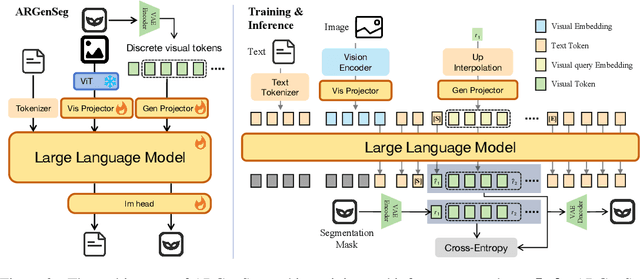


Abstract:We propose a novel AutoRegressive Generation-based paradigm for image Segmentation (ARGenSeg), achieving multimodal understanding and pixel-level perception within a unified framework. Prior works integrating image segmentation into multimodal large language models (MLLMs) typically employ either boundary points representation or dedicated segmentation heads. These methods rely on discrete representations or semantic prompts fed into task-specific decoders, which limits the ability of the MLLM to capture fine-grained visual details. To address these challenges, we introduce a segmentation framework for MLLM based on image generation, which naturally produces dense masks for target objects. We leverage MLLM to output visual tokens and detokenize them into images using an universal VQ-VAE, making the segmentation fully dependent on the pixel-level understanding of the MLLM. To reduce inference latency, we employ a next-scale-prediction strategy to generate required visual tokens in parallel. Extensive experiments demonstrate that our method surpasses prior state-of-the-art approaches on multiple segmentation datasets with a remarkable boost in inference speed, while maintaining strong understanding capabilities.
PruneHal: Reducing Hallucinations in Multi-modal Large Language Models through Adaptive KV Cache Pruning
Oct 22, 2025Abstract:While multi-modal large language models (MLLMs) have made significant progress in recent years, the issue of hallucinations remains a major challenge. To mitigate this phenomenon, existing solutions either introduce additional data for further training or incorporate external or internal information during inference. However, these approaches inevitably introduce extra computational costs. In this paper, we observe that hallucinations in MLLMs are strongly associated with insufficient attention allocated to visual tokens. In particular, the presence of redundant visual tokens disperses the model's attention, preventing it from focusing on the most informative ones. As a result, critical visual cues are often under-attended, which in turn exacerbates the occurrence of hallucinations. Building on this observation, we propose \textbf{PruneHal}, a training-free, simple yet effective method that leverages adaptive KV cache pruning to enhance the model's focus on critical visual information, thereby mitigating hallucinations. To the best of our knowledge, we are the first to apply token pruning for hallucination mitigation in MLLMs. Notably, our method don't require additional training and incurs nearly no extra inference cost. Moreover, PruneHal is model-agnostic and can be seamlessly integrated with different decoding strategies, including those specifically designed for hallucination mitigation. We evaluate PruneHal on several widely used hallucination evaluation benchmarks using four mainstream MLLMs, achieving robust and outstanding results that highlight the effectiveness and superiority of our method. Our code will be publicly available.
Every Step Evolves: Scaling Reinforcement Learning for Trillion-Scale Thinking Model
Oct 21, 2025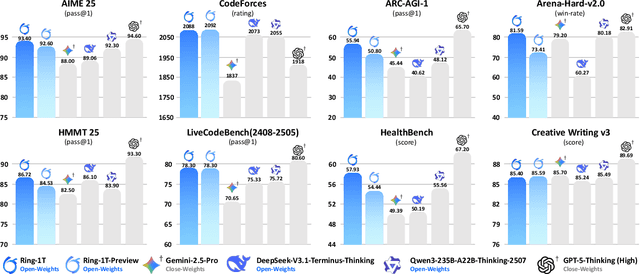
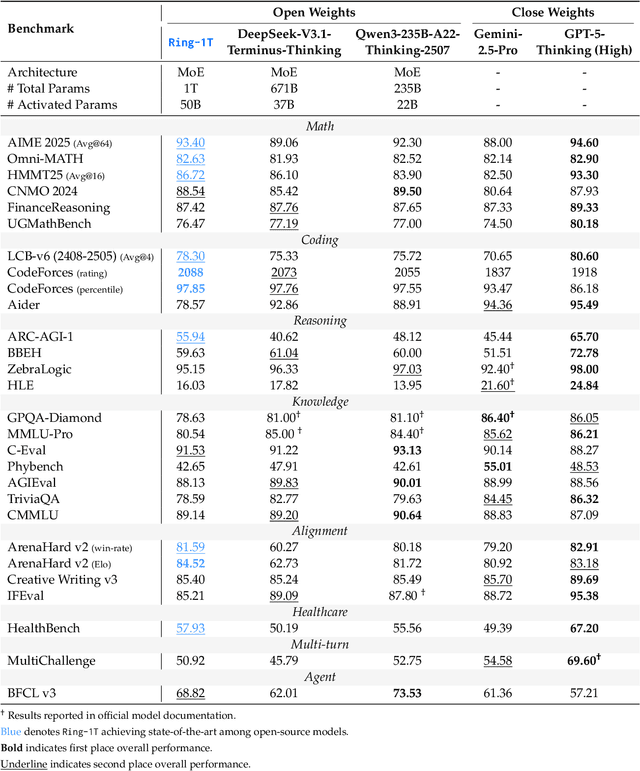
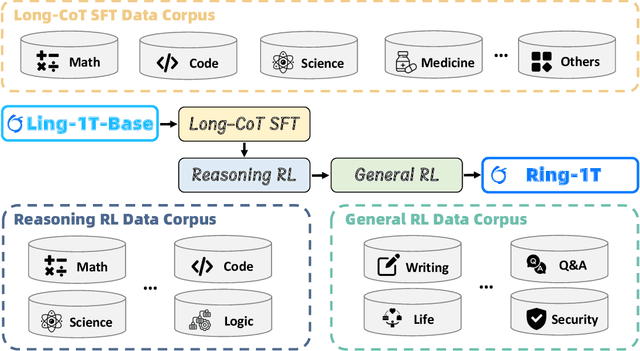
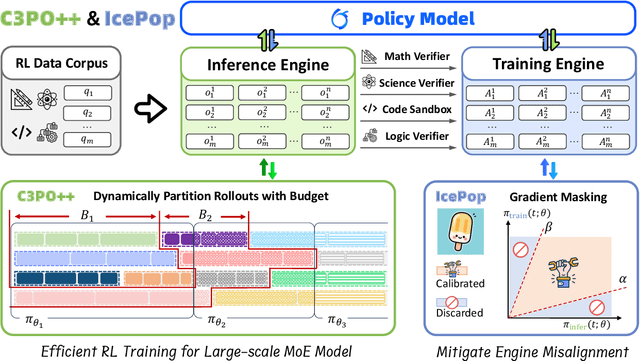
Abstract:We present Ring-1T, the first open-source, state-of-the-art thinking model with a trillion-scale parameter. It features 1 trillion total parameters and activates approximately 50 billion per token. Training such models at a trillion-parameter scale introduces unprecedented challenges, including train-inference misalignment, inefficiencies in rollout processing, and bottlenecks in the RL system. To address these, we pioneer three interconnected innovations: (1) IcePop stabilizes RL training via token-level discrepancy masking and clipping, resolving instability from training-inference mismatches; (2) C3PO++ improves resource utilization for long rollouts under a token budget by dynamically partitioning them, thereby obtaining high time efficiency; and (3) ASystem, a high-performance RL framework designed to overcome the systemic bottlenecks that impede trillion-parameter model training. Ring-1T delivers breakthrough results across critical benchmarks: 93.4 on AIME-2025, 86.72 on HMMT-2025, 2088 on CodeForces, and 55.94 on ARC-AGI-v1. Notably, it attains a silver medal-level result on the IMO-2025, underscoring its exceptional reasoning capabilities. By releasing the complete 1T parameter MoE model to the community, we provide the research community with direct access to cutting-edge reasoning capabilities. This contribution marks a significant milestone in democratizing large-scale reasoning intelligence and establishes a new baseline for open-source model performance.
 Add to Chrome
Add to Chrome Add to Firefox
Add to Firefox Add to Edge
Add to Edge